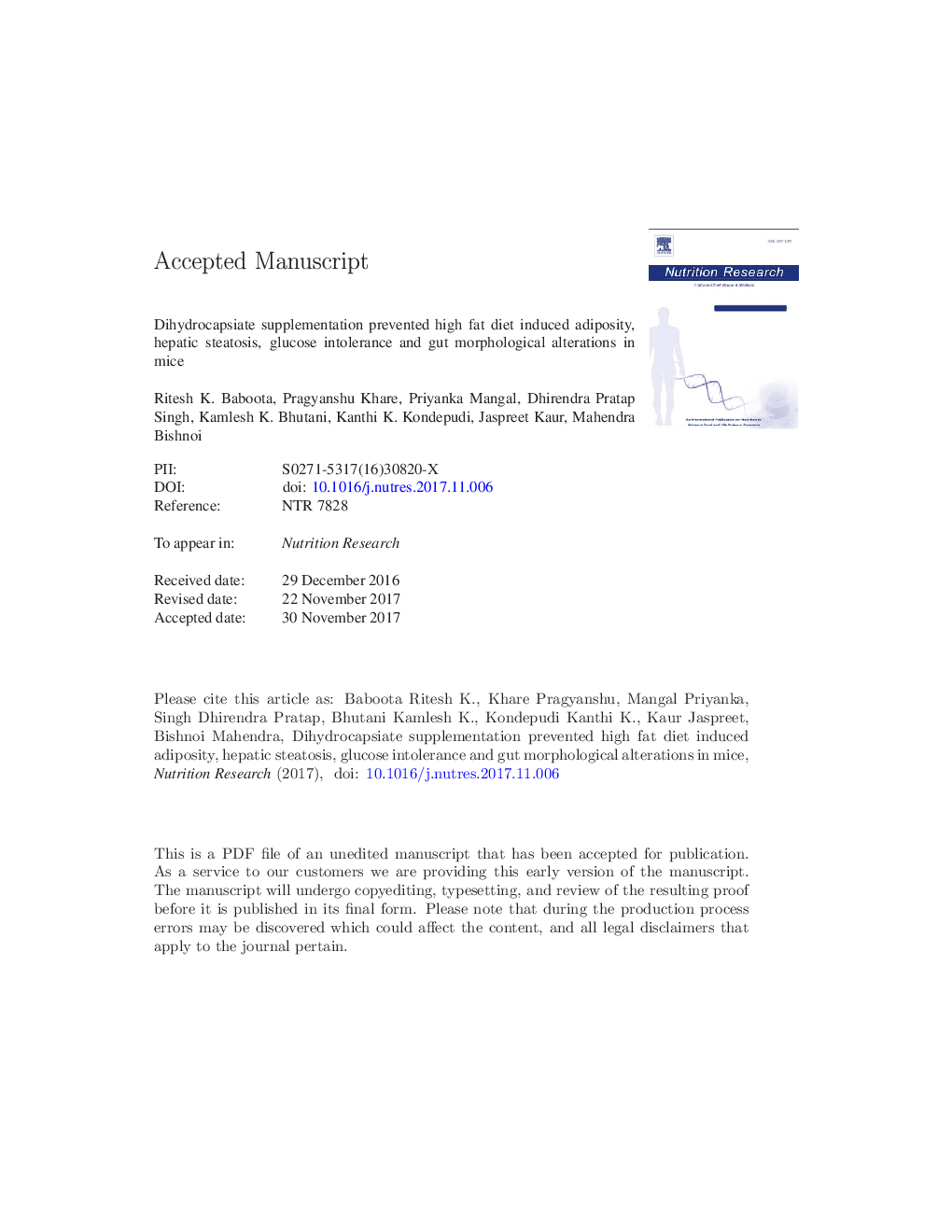| Article ID | Journal | Published Year | Pages | File Type |
|---|---|---|---|---|
| 8634250 | Nutrition Research | 2018 | 56 Pages |
Abstract
Despite the lipolytic and thermogenic properties of capsaicin, its putative use as a weight-lowering dietary supplement has been limited because of the burning sensation caused by capsaicin when it comes in contact with mucous membranes. A potential alternative to capsaicin are the capsinoids, nonpungent capsaicin analogs that exhibit effects similar to capsaicin. Whereas the antiobesity properties of capsinoids have been reported, the effectiveness of FDA-approved synthetic dihydrocapsiate has not yet been investigated. In the present study, we hypothesized that dihydrocapsiate might ameliorate high-fat diet (HFD)-induced metabolic disorders in a manner similar to capsaicin and therefore can be its nonpungent alternative. To test this hypothesis, HFD-fed mice were orally administered dihydrocapsiate (2 and 10Â mg/kg body weight) for 12Â weeks. Dihydrocapsiate modestly reduced the HFD-induced weight gain and significantly prevented the associated hyperglyceridemia and hyperinsulinemia while improving glucose tolerance. Histological and gene expression analysis showed that dihydrocapsiate significantly prevented the lipid accumulation in white adipose tissue and brown adipose tissue via targeting genes involved in energy expenditure and mitochondrial biogenesis, respectively. Dihydrocapsiate corrected hepatic triglyceride concentrations and normalized expression of genes regulating hepatic lipid and glucose metabolism. Moreover, dihydrocapsiate administration significantly improved gut morphology and altered gut microbial composition, resulting in reduced host energy availability. Collectively, these results indicate that dihydrocapsiate administration improved glucose tolerance, prevented adiposity and hepatic steatosis, as well as improved HFD-induced gut alterations, positing dihydrocapsiate as a potential food ingredient for the dietary management of HFD-induced metabolic alterations.
Keywords
BATvWATNRFAINDlk1Dulbecco Modified Eagle MediumHFDSCFAPPARγPLIN1visceral white adipose tissuePGC1αACOX1FABP4acyl-CoA oxidase 1PPARαPEPCKTFAMLPSG6PaseTMEM26PBSAdipoTNFαERRαtranscription factor A, mitochondrialIL-6TRPV1DMEMPRDM16SREBP1FBSCCAAT/enhancer-binding protein betaperoxisome proliferator-activated receptor gamma coactivator 1-alphac/ebpβH&EUcp1adiponectinperoxisome proliferator-activated receptor alphaHepatic steatosisfatty acid synthaseshort-chain fatty acidinterleukin 6brown adipose tissueANOVAELISAEnzyme-linked immunosorbent assaytumor necrosis factor alphaPR domain containing 16high-fat dietfetal bovine serumbody mass indexBMINuclear respiratory factor 1Glucose intoleranceFasnphosphate buffer salinephosphoenolpyruvate carboxykinaseLIPElipopolysaccharideObesityAmerican Institute of NutritionHematoxylin and Eosinfatty acid binding protein 4sterol regulatory element-binding protein 1uncoupling protein 1transmembrane protein 26Perilipin 1Transient receptor potential channelPeroxisome proliferator-activated receptor gammaglucose 6-phosphatase
Related Topics
Life Sciences
Biochemistry, Genetics and Molecular Biology
Endocrinology
Authors
Ritesh K. Baboota, Pragyanshu Khare, Priyanka Mangal, Dhirendra Pratap Singh, Kamlesh K. Bhutani, Kanthi K. Kondepudi, Jaspreet Kaur, Mahendra Bishnoi,
